The AMD Radeon R9 Fury Review, Feat. Sapphire & ASUS
by Ryan Smith on July 10, 2015 9:00 AM ESTCompute
Shifting gears, we have our look at compute performance. As compute performance will be more significantly impacted by the reduction in CUs than most other tests, we’re expecting the performance hit for the R9 Fury relative to the R9 Fury X to be more significant here than under our gaming tests.
Starting us off for our look at compute is LuxMark3.0, the latest version of the official benchmark of LuxRender 2.0. LuxRender’s GPU-accelerated rendering mode is an OpenCL based ray tracer that forms a part of the larger LuxRender suite. Ray tracing has become a stronghold for GPUs in recent years as ray tracing maps well to GPU pipelines, allowing artists to render scenes much more quickly than with CPUs alone.

For LuxMark with the R9 Fury X already holding the top spot, the R9 Fury cards easily take the next two spots. One interesting artifact of this is that the R9 Fury’s advantage over the GTX 980 is actually greater than the R9 Fury X’s over the GTX 980 Ti’s, both on an absolute and relative basis. This despite the fact that the R9 Fury is some 13% slower than its fully enabled sibling.
For our second set of compute benchmarks we have CompuBench 1.5, the successor to CLBenchmark. CompuBench offers a wide array of different practical compute workloads, and we’ve decided to focus on face detection, optical flow modeling, and particle simulations.
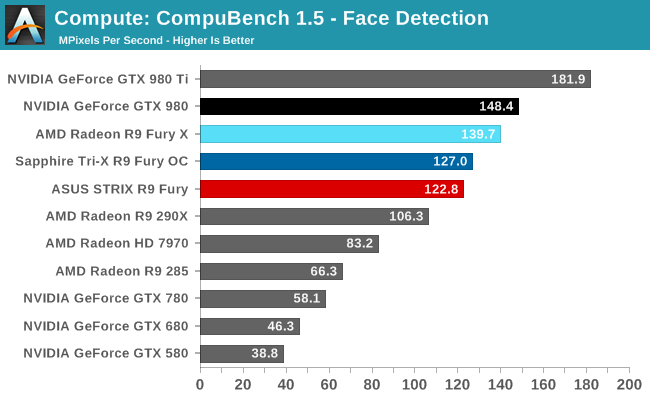
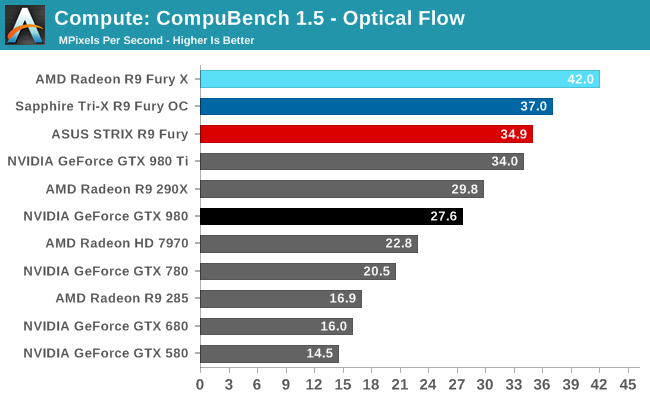

Not unlike LuxMark, tests where the R9 Fury X did well have the R9 Fury doing well too, particularly the optical flow sub-benchmark. The drop-off in that benchmark and face detection is about what we’d expect for losing 1/8th of Fiji’s CUs. On the other hand the particle simulation benchmark is hardly fazed beyond the clockspeed drop, indicating that the bottleneck lies elsewhere.
Our 3rd compute benchmark is Sony Vegas Pro 13, an OpenGL and OpenCL video editing and authoring package. Vegas can use GPUs in a few different ways, the primary uses being to accelerate the video effects and compositing process itself, and in the video encoding step. With video encoding being increasingly offloaded to dedicated DSPs these days we’re focusing on the editing and compositing process, rendering to a low CPU overhead format (XDCAM EX). This specific test comes from Sony, and measures how long it takes to render a video.
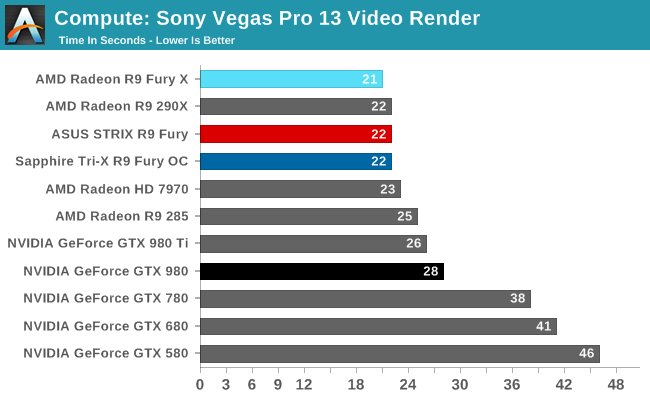
At this point Vegas is becoming increasingly CPU-bound and will be due for replacement. The R9 Fury comes in one second behind the chart-topping R9 Fury X, at 22 seconds.
Moving on, our 4th compute benchmark is FAHBench, the official Folding @ Home benchmark. Folding @ Home is the popular Stanford-backed research and distributed computing initiative that has work distributed to millions of volunteer computers over the internet, each of which is responsible for a tiny slice of a protein folding simulation. FAHBench can test both single precision and double precision floating point performance, with single precision being the most useful metric for most consumer cards due to their low double precision performance. Each precision has two modes, explicit and implicit, the difference being whether water atoms are included in the simulation, which adds quite a bit of work and overhead. This is another OpenCL test, utilizing the OpenCL path for FAHCore 17.
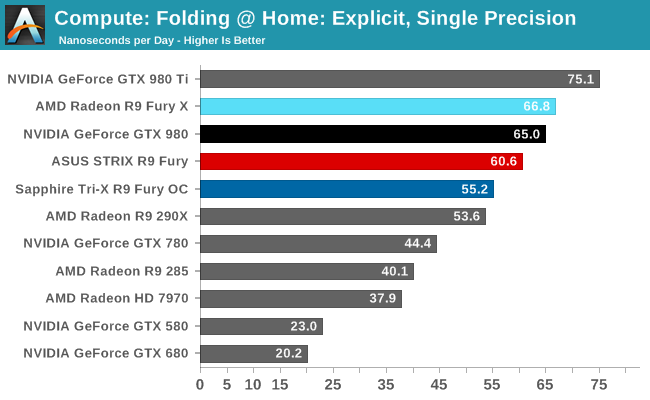
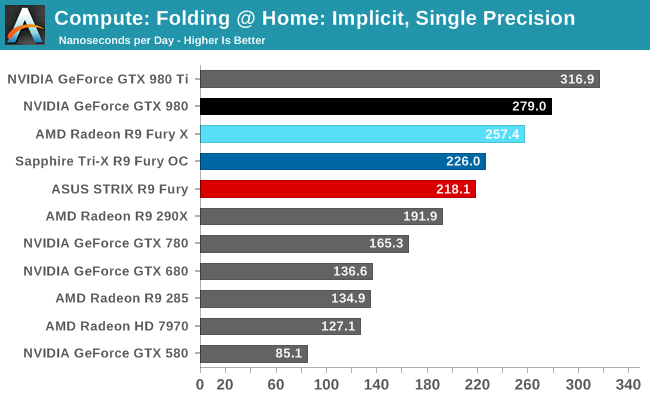

Overall while the R9 Fury doesn’t have to aim quite as high given its weaker GTX 980 competition, FAHBench still stresses the Radeon cards. Under single precision tests the GTX 980 pulls ahead, only surpassed under double precision thanks to NVIDIA’s weaker FP64 performance.
Wrapping things up, our final compute benchmark is an in-house project developed by our very own Dr. Ian Cutress. SystemCompute is our first C++ AMP benchmark, utilizing Microsoft’s simple C++ extensions to allow the easy use of GPU computing in C++ programs. SystemCompute in turn is a collection of benchmarks for several different fundamental compute algorithms, with the final score represented in points. DirectCompute is the compute backend for C++ AMP on Windows, so this forms our other DirectCompute test.
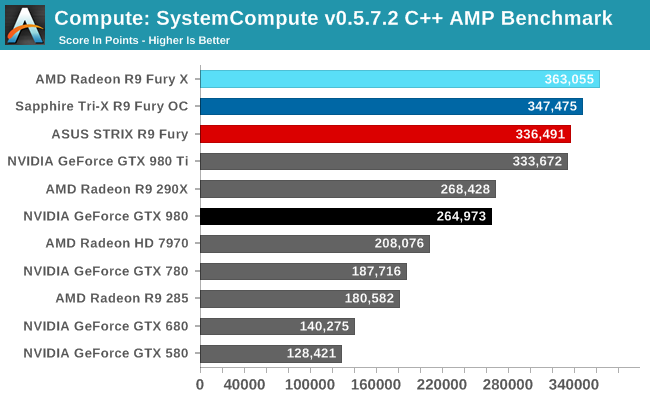
As with our other tests the R9 Fury loses some performance on our C++ AMP benchmark relative to the R9 Fury X, but only around 8%. As a result it’s competitive with the GTX 980 Ti here, blowing well past the GTX 980.










288 Comments
View All Comments
Oxford Guy - Thursday, July 16, 2015 - link
"What exactly is the logic there?"I really need to spell it out for you?
The logic is that the 480 was a successful product despite having horrid performance per watt and a very inefficient (both in terms of noise and temps) cooler. It didn't get nearly the gnashing of teeth the recent AMD cards are getting and people routinely bragged about running more than one of them in SLI.
CiccioB - Thursday, July 16, 2015 - link
No, it was not a successful product at all, though it was still the fastest card on market.The successful card was the 460 launched few months later and surely the 570/580 cards which brought the corrections to the original GF100 that nvidia itself said it was bugged.
Here, instead, we have a card which uses a lot of power, it is not on top of the charts and there's really no fix at the horizont for it.
The difference was that with GF100 nvidia messed up the implementation of the architecture which was then fixxed, here we are seeing what is the most advanced implementation of a really not so good architecture that for 3 years has struggled to keep the pace of the competitions which at the end has decided to go with a 1024 shaders + 128bit wide bus in a 220mm^2 die space against a 1792 shader + 256bit wide bus in a 356mm^2 die space instead of trying to have the latest fps longer bar war.
AMD, please, review your architecture completely or we are doomed with next PP.
Oxford Guy - Tuesday, July 21, 2015 - link
"No, it was not a successful product at all"It was successful. Enthusiasts bought them in a significant number and review sites showed off their two and three card rigs. The only site that even showed their miserable performance per watt was techpowerup
Count Vladimir - Thursday, July 16, 2015 - link
So we are discussing 6 year old products now? Is that your version of logic? Yes, it was hot, yes, it was buggy but it was still the fastest video card in its era, that's why people bragged about SLI'ing it. Fury X isn't.Oxford Guy - Tuesday, July 21, 2015 - link
"So we are discussing 6 year old products now?" strawmancelebrevida - Thursday, July 16, 2015 - link
Looks like Jason Evangelho of PCWorld has the matter settled. In his article:http://www.pcworld.com/article/2947547/components-...
He shows that R9 Fury x2 is on par with GTX 980 Ti x 2 and blows away GTX 980 x2. Considering that R9 Fury x2 is much cheaper than GTX 980 Ti x2 and also R9 Fury is optimized for upcoming DX12, it looks like R9 Fury is the clear winner in cost/performance.
xplane - Saturday, October 17, 2015 - link
So with this GPU I could use 5 monitors simultaneously? Right?kakapoopoo - Wednesday, January 4, 2017 - link
i got the sapphire version up to 1150 stably using msi after burner w/o changing anything else